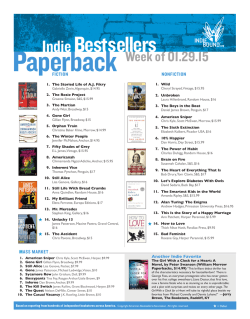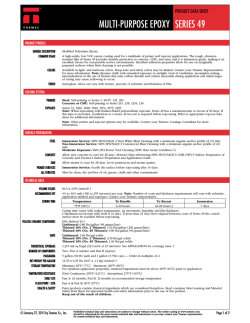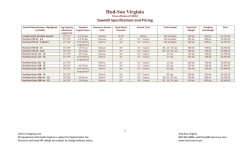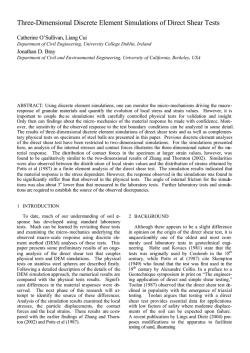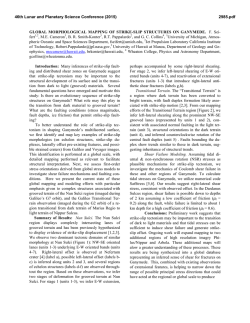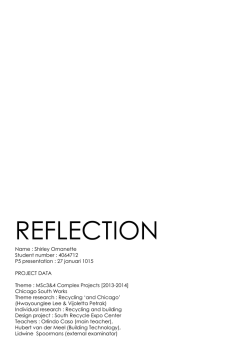
Hi-Res - Powers Fasteners
Code listed ICC-ES ESR-3066 T308+™ Epoxy Adhesive Injection System PRODUCT DESCRIPTION T308+ is a two-component epoxy adhesive anchoring system. The system includes injection adhesive in plastic cartridges, mixing nozzles, dispensing tools and hole cleaning equipment. The T308+ is designed for bonding threaded rod and reinforcing bar into drilled holes in concrete base materials. GENERAL Applications AND Uses • Bonding steel threaded rod into hardened concrete and concrete masonry (CMU) • S uitable to resist loads in uncracked concrete base materials for cases where anchor design theory and criteria applies • Evaluated for installation into dry, clean holes only • Can be installed in a wide range of base material temperatures FEATURES AND Benefits • Made in the USA • Cartridge design allows for multiple uses using extra mixing nozzles • Mixing nozzles proportion adhesive and provide simple delivery method into drilled holes • Evaluated and recognized for multiple embedments (see installation specifications) APPROVALS AND LISTINGS packaging Dual (Side-by-Side) Cartridge 21.5 fl. oz. (630 mL) Storage life & conditions Two years in a dry, dark environment with temperatures ranging from 40-95˚F. ANcHOR Size range (typ) 3/8" to 7/8" diameter threaded rod Guide specifications CSI Divisions: 03151–Concrete Anchoring, 04081-Masonry Anchorage, 05090-Metal Fastenings. Adhesive anchoring system shall be T308+ as supplied by Powers Fasteners, Inc. Brewster, NY. Anchors shall be installed in accordance with published instructions and requirements of the Authority Having Jurisdiction. Normal-weight concrete Grouted concrete masonry Hollow concrete masonry Brick masonry (URM) This Product Available In ® ICC-ES ESR-3066 Powers Design Assist Real Time Anchor Design Software www.powersdesignassist.com 2 International Code Council, Evaluation Service (ICC-ES) ESR-3066 for concrete Conforms to requirements of ASTMC 881, Types I, II, IV & V, Grade 3, Class C (with exception of gel time) Compliant with NSF/ANSI 61 for drinking water system components – health effects; minimum requirements formaterials in contact with potable water and water treatment Department of Transportation listings (see www.powers.comor contact transportation agency) Suitable base materials Code listed T308+™ Epoxy INSTALLATION SPECIFICATIONS Installation Specifications for Steel Threaded Rod (Solid Concrete Base Materials) Dimension/Property Nominal Anchor Size Notation Units 3/8’’ 1/2” 5/8” 3/4’’ 7/8” Nominal anchor diameter d in. (mm) 0.375 (9.5) 0.500 (12.7) 0.625 (15.9) 0.750 (19.1) 0.875 (31.8) Nominal diameter of drilled hole do in. 7/16 ANSI 9/16 ANSI 3/4 ANSI 7/8 ANSI 1 ANSI Minimum embedment depth1 hef in. (mm) 2 (50) 3-3/8 (86) 2-1/2 (62) 4 (102) 3-1/4 (83) 5-5/8 (143) 3-3/8 (86) 6-3/4 (171) 4 (102) 7-7/8 (200) Minimum concrete member thickness1 hmin in. (mm) 4 (102) 5 (127) 5 (127) 6 (153) 6 (153) 9 (229) 7 (178) 10-1/8 (257) 8 (203) 12 (305) Minimum spacing distance1 smin in. (mm) Critical edge distance cac in. (mm) Maximum torque (only possible after curing) Tmax ft.-lbs. (N-m) 3 (76) 4 (102) 3-3/4 (95) 6-3/4 (171) 5 (127) 14 (19) 9-1/2 (241) 25 (34) 4-7/8 (124) 6-1/2 (165) 12 (305) 70 (95) 5 (127) 6-3/4 (171) 14-1/2 (368) 120 (163) 8 (203) 8 (203) 15-3/4 (400) 140 (190) 1. For use with the design provisions of ACI 318 Appendix D and ICC-ES AC308 Appendix A, Section 3.3. Installation Specifications for Threaded Rod (Hollow Base Materials) Dimension/Property Notation Units Nominal threaded rod diameter d Nominal stainless steel tube size Nominal Anchor Size 3/8’’ 1/2” in. (mm) 0.375 (9.5) 0.500 (12.7) - in. 3/8 1/2 Nominal diameter of drilled hole do, (dbit) in. 1/2 ANSI 5/8 ANSI Maximum torque (only possible after full cure time of adhvesive) Tmax ft.-lbs. (N-m) 10 (8) 10 (8) 1. For unreinforced masonry (URM) see page 12. Threaded Rod and Deformed Reinforcing Bar Material Properties Steel Description (General) Steel Specification (ASTM) Nominal Anchor Size (inch) Minimum Yield Strength, fy (ksi) Minimum Ultimate Strength, fu (ksi) Carbon rod 3/8 through 7/8 36.0 58.0 High strength carbon rod A 36 or F1554 Grade 36 A193, Grade B7 3/8 through 7/8 105.0 120.0 Stainless rod (Alloy 304/316) F593, (Condition CW) 3/8 through 5/8 65.0 100.0 3/8 through 7/8 45.0 85.0 Grade 60 reinforcing bar A 615, A 706 A767, or A996 3/8 through 7/8 (#3 through #7) 60.0 90.0 1 Detail of Steel Hardware Elements used with Injection Adhesive System Threaded Rod or Rebar 1. ASTM A706 reports a minimum ultimate strength of 80,000 PSI (80.0 ksi) 3 T308+™ Epoxy installation instructions (solid base materials) 4 1. 1.Drill hole into the concrete using a rotary-percussion power drill and a carbide-tipped SDS or SDS-Plus type bit. Drill bit size should be 1/16” larger than the anchor rod for sizes up to 1/2” diameter; and 1/8” larger for anchor rods 5/8” through 7/8” diameter. 2. 2.Blow out hole using oil-free compressed air at a minimum of 70 psi with a nozzle. While blowing air, insert the nozzle into the hole until in contact with the bottom, and then withdraw; whereby the blowing procedure takes at least one full second. 3. 3.Insert an appropriate size nylon cleaning brush into the hole with a thrusting, twisting motion. Once the brush is in contact with the bottom of the hole, turn the brush three full revolutions. Then quickly withdraw the brush with a vigorous, twisting pull. 4. 4. Repeat brushing of hole as per Step 3 above. 5. 5. Repeat blow out of hole with air as per Step 2 above. 6. 6. Screw the supplied mixing nozzle on to the cartridge, insert cartridge into an approved dispensing tool supplied by Powers Fasteners, and dispense epoxy on a disposable surface until a uniform color is achieved. Then insert the cartridge nozzle into the borehole until in contact with the bottom. Then, dispense the adhesive while slowly withdrawing the nozzle until borehole is approximately two-thirds full, and then withdraw the nozzle. 7. 7.Slowly insert a clean and oil-free rod into the adhesive in the hole with a counter-thread, turning motion until it contacts the bottom of the hole. 8. 8.Immediately adjust the alignment of the anchor rod in the hole. Check that the anchor remains fully in the hole. An air bubble in the hole could cause the anchor rod to rise after insertion. If this occurs, immediately turn the anchor with downward pressure to work the air out. Do not disturb, torque or load the anchorage until the adhesive is fully cured. T308+™ Epoxy INSTALLATION INSTRUCTIONS (Hollow BASE MATERIALS) Drilling 1- Drill a hole into the base material with a rotary drill tool to the size and embedment for the required screen size The tolerances of the drill bit used should meet the requirements of ANSI B212.15. Precaution: Wear suitable eye and skin protection. Avoid inhalation of dusts during drilling and/or removal. Hole Cleaning - Blow 2x, Brush 2x, Blow 2x 2x Preparing 2 - Blow out hole using oil-free compressed air at a minimum of 70 psi with a nozzle. While blowing air, insert the nozzle into the hole until in contact with the bottom for not less than one second, and then withdraw. Repeat. Insert an appropriate size nylon cleaning brush into the hole with a thrusting, twisting motion. Once the brush is in contact with the bottom of the hole, turn the brush three revolution, and then quickly withdraw the brush with a vigorous, twisting pull. • Repeat brushing of the hole • Repeat blow out of hole with compressed air as per above. When finished the hole should be clean and free of dust, debris, ice, grease, oil or other foreign material. 3 - Check adhesive expiration date on cartridge label. Do not use expired product. Review Material Safety Data Sheet (MSDS) before use. Cartridge temperature must be between 40°F - 95°F (0°C - 35°C) when in use. Review gel (working) time and curing time table. Consideration should be given to the reduced gel (working) time of the adhesive in warm temperatures. Attach a supplied mixing nozzle to the cartridge and load the cartridge into the correct dispensing tool. A new mixing nozzle must be used for every working interruption longer than published working time (see gel time and curing time table) as well for new cartridges. 4 - P rior to inserting the clean and oil free anchor rod. Verify anchor element is straight and free of surface damage. 5 - For new cartridges and nozzles; Prior to dispensing adhesive into the drilled hole, squeeze out separately a minimum three full strokes of the mixed adhesive. Discard non-uniform adhesives until the mixed shows a consistent gray color. Review and note the published working and cure times (see gel time and curing time table) prior to injection of the mixed adhesive into the screen tube. Installing 6 - Insert a screen tube of suitable length into the cleaned anchor hole. 7 - Fill the screen tube full with adhesive starting from the bottom or back of the tube. Slowly withdraw the mixing nozzle as the screen fills to avoid creating air pockets or voids. A plastic extension tube supplied by Powers Fasteners must be used with the mixing nozzle if the back of the screen tube cannot be reached. 8 -Prior to inserting the anchor rod into the screen tube inspect it to ensure that it is free of dirt, grease, oil or other foreign material. Push the threaded rod into the screen tube while turning slightly to ensure positive distribution of the adhesive until the back of the tube is reached. Curing and Fixing 9- Allow the adhesive anchor to cure to the specified full curing time prior to applying any load. Do not disturb, torque or load the anchor until it is fully cured (see gel time and curing time table). 10- After full curing of the adhesive anchor, a fixture can be installed to the anchor and tightened up to the maximum torque (see installation specifications for threaded rod in hollow concrete base material) by using a calibrated torque wrench. Take care not to exceed the maximum torque for the selected anchor. 5 T308+™ Epoxy RefereNce tables for installatioN Gel (working) Time and Curing Table Temperature of base material F C o o 50 60 70 80 90 100 10 15 20 25 32 37 Gel (working) time Full curing time 35 minutes 20 minutes 10 minutes 7 minutes 5 minutes 3 minutes 48 hours 36 hours 24 hours 24 hours 24 hours 12 hours Hole Cleaning Equipment Selction Table for T308+ Threaded rod Diameter (inch) 3/8 1/2 5/8 3/4 7/8 6 ANSI Drill Bit Diameter (inch) 7/16 9/16 3/4 7/8 1 Compressed air nozzle (all hole size) Nylon Brush (Cat. #) Nylon Brush Length (in) 07931 07932 07933 07933 07934 08292 8-1/2 8-1/2 12 13 13 1 performance data Tension Design Information for Steel Threaded Rod in Normal-Weight Concrete (For use with load combinations taken from ACI 318 Section 9.2)1,2 AC308 Criteria Symbol Anchor Nominal Diameters Units 3/8 1/2 5/8 3/4 7/8 Anchor diameter d in. 0.375 0.500 0.625 0.750 0.875 ANSI Drill bit diameter do in. 7/16 9/16 3/4 7/8 1 Minimum embedment hef in. (mm) 2 (50) 3-3/8 (86) 2-1/2 (62) 4 (102) 3-1/4 (83) 5-5/8 (143) 3-3/8 (86) 6-3/4 (171) 4 (102) 7-7/8 (202) Minimum concrete member thickness2 hmin in. (mm) 4 (102) 5 (127) 5 (127) 6 (153) 6 (153) 9 (229) 7 (178) 10-1/8 (257) 8 (203) 7-7/8 (200) Minimum spacing distance2 Smin in. (mm) Critical edge distance2 Cac in. (mm) Minimum edge distance2 Cmin in. (mm) 3 (76) 3-3/4 (95) 4-7/8 (124) 5 (127) 6 (153) Maximum torque3 Tmax in. (mm) 14 (19) 25 (34) 73 (95) 119 (163) 144 (190) Effective tensile area Ase in.2 0.0775 0.1419 0.2260 0.3345 0.4617 F1554 Grade 36 fy lb/in2 36,000 A193 Grade B7 fy lb/in2 105,000 Anchor Steel F1554 Grade 36 fut lb/in2 58,000 Ultimate Strength A193 Grade B7 fut lb/in Nominal steel strength of single anchor, tension G1554 Grade 36 Anchor Steel Yield Strength A193 Grade B7 Reduction factor for steel strength in tension Nominal steel strength of single anchor, shear F1554 Grade 36 3 (76) 4 (102) 3-3/4 (95) 6-3/4 (171) 5 (127) 9-1/2 (941) 4-7/8 (124) 6-1/2 (165) lbf - - 14-1/2 (368) 8 (203) 15-3/4 (400) 4,495 8,230 13,110 19,400 26,780 9,685 17,735 28,250 41,810 57,710 2,695 4,940 7,865 11,640 16,070 4,845 10,640 16,950 25,085 34,625 0.75 Vsa lbf Reduction factor for steel strength in shear - - 0.65 Effectiveness factor for uncracked concrete A193 Grade B7 6-3/4 (171) 8 (203) 125,000 2 Nsa 12 (305) 5 (127) kc, uncr - 24 Strength reduction factor for tension, concrete failure modes, Condition B Ø - 0.65 Strength reduction factor for shear, concrete failure modes, Condition B Ø - 0.70 Anchor category, periodic inspection - - 2 Strength reduction factor for bond strength, dry concrete, with Periodic Inspection Ød - 0.55 kd - 1.00 Anchor category, periodic inspection - - 1 Strength reduction factor for bond strength, dry concrete, with Continuous Inspection Ød - 0.65 0.65 0.65 0.65 0.55 0.55 0.55 0.55 0.45 0.45 kd - 1.00 1.00 1.00 1.00 1.00 1.00 1.00 1.00 0.70 0.70 Characteristic bond strength, uncracked concrete, Temperature Range A tk, uncr psi 676 681 418 523 Characteristic bond strength, uncracked concrete, Temperature Range B tk, uncr psi 406 409 251 314 2 0.55 1.00 1 2 2 0.55 0.55 1.00 1 1.00 1 3 3 0.45 0.45 1.00 2 1.00 2 3 3 0.45 0.45 1.00 2 1.00 2 3 3 0.45 0.45 0.70 3 0.70 3 645 288 1. The data presented is applicable to use with uncracked, normal weight, structural concrete having a compressive strength of between 2,500 and 8,500 psi. 2. The T308+ is recognized for applications in wet or dry concrete, non-acidic environment, minimum base material temperature of 50°F, and in holes drilled with a carbide drill bit used with a hammer drill. 3. Characteristic bond strength is dependent on temperature: Temperature Range A: Maximum short term temperature = 110°F and Maximum long term temperature = 75°F. Temperature Range B: Maximum short term temperature = 162°F and Maximum long term temperature = 110°F. Short term elevated concrete temperatures are those that occur over brief intervals, such as due to diurnal cycling, and long term concrete temperatures are roughly constant over significant periods of time. 4. For short-term loads such as due to wind, and for Temperature Range B only, the listed bond strength may be increased 40 percent. 5. The T308+ anchor system is suitable for installation in vertical down or horizontal installation applications. 7 T308+™ Epoxy Factored Design Strength (øN and øV ) in Accordance with ACI 318 Appendix D and ICC-ES AC308 Annex A: n n 1. Tabular values are provided for illustration and are applicable for single anchors installed in uncracked normal-weight concrete with minimum slab thickness, ha = hmin, and with the following conditions: - ca1 is greater than or equal to the critical edge distance, - ca2 is greater than or equal to 1.5 times ca1. 2. Calculations were performed according to ACI 318-05 Appendix D and ICC-ES AC308 Annex A, Section 3.3. The load level corresponding to the failure mode is listed (e.g. For tension: steel, concrete breakout or bond strength; For shear: steel, concrete breakout or pryout strength). The lowest load level controls. 3. Strength reduction factors (f) for steel strength and concrete breakout strength are based on ACI 318 Section 9.2 for load combinations. Condition B was assumed. 4. Strength reduction factors (f) for bond strength are determined from reliability testing and qualification in accordance with ICC-ES AC308 and are tabulated in this product information and in ESR-2582. 5. Tabular values are permitted for static loads only, seismic loading is not considered with these tables. Periodic special inspection must be performed where required by code or the Authority Having Jurisdiction (AHJ). See ICC-ES AC308 Annex A, Section 14.4 and ESR-2582. 6. Tabular values are not permitted for anchors subjected to tension resulting from sustained loading. Please see ICC-ES AC308 Annex A, Section 3.3 for the supplement design requirement for this loading condition. 7. For designs that include combined tension and shear, the interaction of tension and shear loads must be calculated in accordance with ACI 318-05 Appendix D. 8. Interpolation is not permitted to be used with the tabular values. For intermediate base material compressive strengths, please see ACI 318-05 Appendix D, ICC-ES AC308 Annex A, Section 3.3 and information included in this product supplement. For other design conditions including seismic considerations please see ACI 318-05 Appendix D and ICC-ES AC308 Annex A, Section 3.3 and ESR-2582. 9. Long term concrete temperatures are roughly constant over significant periods of time. Short-term elevated temperatures are those that occur over brief intervals, e.g. as a result of diurnal cycling. Tension Design Strength for T308+ Installed into Uncracked Concrete in Dry Hole Condition for Temperature Range A Maximum long term temperature = 75˚F (24˚C), Maximum short term temperature = 110˚F (43˚C) Steel Threaded Rod and Rebar Elements Min. Concrete Compressive Strength, f’c (psi) Nominal Anchor Size (in.) Embed.Depth h (in.) 2,500 to 8,000 A 307, Grade C F 593 (SS), CW A 193, Grade B7 Grade 60 Rebar ØNcp or ØNa Tension (lbs.) ØNsa Tension (lbs.) ØNsa Tension (lbs.) ØNsa Tension (lbs.) ØNsa Tension (lbs.) 3,395 5,850 7,315 7,425 6,175 10,650 13,315 13,500 9,830 16,950 21,190 20,925 14,575 21,355 31,405 29,700 20,095 29,455 43,315 40,500 ef 2 3-3/8 2-1/2 3-1/4 4 3-1/4 4-1/2 5-5/8 3-3/8 5-1/4 6-3/4 4 6 7-7/8 3/8 1/2 5/8 3/4 7/8 1,035 1,745 1,740 2,260 2,780 1,465 2,030 2,540 2,285 3,555 4,575 2,870 4,305 5,655 Bond Strength Concrete Breakout Strength Steel Strength Shear Design Strength for T308+ Installed into Uncracked Concrete in Dry Hole Condition for Temperature Range A Maximum long term temperature = 75˚F (24˚C), Maximum short term temperature = 110˚F (43˚C) Nominal Anchor Size (in.) 3/8 1/2 5/8 3/4 7/8 Embed. Depth hef (in.) 2 3-3/8 2-1/2 4 3-1/4 5-5/8 3-3/8 6-3/4 4 7-7/8 2,500 Min. Concrete Compressive Strength, f’c (psi) 3,000 4,000 6,000 8,000 ØVcb or ØVcp Shear (lbs) ØVcb or ØVcp Shear (lbs) ØVcb or ØVcp Shear (lbs) ØVcb or ØVcp Shear (lbs) ØVcb or ØVcp Shear (lbs) 1,115 2,775 2,495 4,530 3,735 6,465 4,865 11,575 4,920 15,440 1,115 3,020 2,730 4,965 3,735 6,465 5,330 11,645 5,390 16,915 1,115 3,490 3,155 5,735 3,735 6,465 5,825 11,645 6,225 19,530 1,115 3,765 3,745 5,990 3,735 6,465 5,825 11,645 7,620 19,550 1,115 3,765 3,745 5,990 3,735 6,465 5,825 11,645 8,800 19,550 Bond Strength 8 Steel Rod and Rebar Elements A 307, Grade C F 593 (SS), CW A 193, Grade Grade 60 Rebar B7 ØVsa Shear (lbs.) ØVsa Shear (lbs.) ØVsa Shear (lbs.) ØVsa Shear (lbs.) 1,765 3,040 3,805 3,860 3,210 5,540 6,925 7,020 5,110 8,815 11,020 10,880 7,580 11,105 16,330 15,445 10,450 15,315 22,525 21,060 Concrete Breakout Strength Steel Strength T308+™ Epoxy Factored Design Strength (øN and øV ) in Accordance with ACI 318 Appendix D and ICC-ES AC308 Annex B: n n 1. Tabular values are provided for illustration and are applicable for single anchors installed in uncracked normal-weight concrete with minimum slab thickness, ha = hmin, and with the following conditions: - ca1 is greater than or equal to the critical edge distance, - ca2 is greater than or equal to 1.5 times ca1. 2. Calculations were performed according to ACI 318-05 Appendix D and ICC-ES AC308 Annex A, Section 3.3. The load level corresponding to the failure mode is listed (e.g. For tension: steel, concrete breakout or bond strength; For shear: steel, concrete breakout or pryout strength). The lowest load level controls. 3. Strength reduction factors (f) for steel strength and concrete breakout strength are based on ACI 318 Section 9.2 for load combinations. Condition B was assumed. 4. Strength reduction factors (f) for bond strength are determined from reliability testing and qualification in accordance with ICC-ES AC308 and are tabulated in this product information and in ESR-2582. 5. Tabular values are permitted for static loads only, seismic loading is not considered with these tables. Periodic special inspection must be performed where required by code or the Authority Having Jurisdiction (AHJ). See ICC-ES AC308 Annex A, Section 14.4 and ESR-2582. 6. Tabular values are not permitted for anchors subjected to tension resulting from sustained loading. Please see ICC-ES AC308 Annex A, Section 3.3 for the supplement design requirement for this loading condition. 7. For designs that include combined tension and shear, the interaction of tension and shear loads must be calculated in accordance with ACI 318-05 Appendix D. 8. Interpolation is not permitted to be used with the tabular values. For intermediate base material compressive strengths, please see ACI 318-05 Appendix D, ICC-ES AC308 Annex A, Section 3.3 and information included in this product supplement. For other design conditions including seismic considerations please see ACI 318-05 Appendix D and ICC-ES AC308 Annex A, Section 3.3 and ESR-2582. 9. Long term concrete temperatures are roughly constant over significant periods of time. Short-term elevated temperatures are those that occur over brief intervals, e.g. as a result of diurnal cycling. Tension Design Strength for T308+ Installed into Uncracked Concrete in Dry Hole Condition for Temperature Range B Maximum long term temperature = 110˚F (43˚C), Maximum short term temperature = 162˚F (72˚C) Nominal Anchor Size (in.) Embed.Depth hef (in.) 2,500 to 8,000 A 307, Grade C F 593 (SS), CW A 193, Grade B7 Grade 60 Rebar ØNcp or ØNa Tension (lbs.) ØNsa Tension (lbs.)) ØNsa Tension (lbs.) ØNsa Tension (lbs.) ØNsa Tension (lbs.) 3,395 5,850 7,315 7,425 6,175 10,650 13,315 13,500 9,830 16,950 21,190 20,925 14,575 21,355 31,405 29,700 20,095 29,455 43,315 40,500 2 3-3/8 2-1/2 3-1/4 4 3-1/4 4-1/2 5-5/8 3-3/8 5-1/4 6-3/4 4 6 7-7/8 3/8 1/2 5/8 3/4 7/8 Steel Threaded Rod and Rebar Elements Min. Concrete Compressive Strength, f’c (psi) 620 1,050 1,045 1,360 1,670 880 1,220 1,525 1,375 2,135 2,745 1,730 2,590 3,400 Bond Strength Concrete Breakout Strength Steel Strength Shear Design Strength for T308+ Installed into Uncracked Concrete in Dry Hole Condition for Temperature Range B Maximum long term temperature = 110˚F (43˚C), Maximum short term temperature = 162˚F (72˚C) Nominal Anchor Size (in.) 3/8 1/2 5/8 3/4 7/8 Embed. Depth hef (in.) 2 3-3/8 2-1/2 4 3-1/4 5-5/8 3-3/8 6-3/4 4 7-7/8 Steel Rod and Rebar Elements Min. Concrete Compressive Strength, f’c (psi) 2,500 3,000 4,000 6,000 8,000 ØVcb or ØVcp Shear (lbs) ØVcb or ØVcp Shear (lbs) ØVcb or ØVcp Shear (lbs) ØVcb or ØVcp Shear (lbs) ØVcb or ØVcp Shear (lbs) 670 2,260 2,250 3,600 2,240 3,880 3,495 6,990 4,920 11,760 670 2,260 2,250 3,600 2,240 3,880 3,495 6,990 5,390 11,760 670 2,260 2,250 3,600 2,240 3,880 3,495 6,990 5,975 11,760 670 2,260 2,250 3,600 2,240 3,880 3,495 6,990 5,975 11,760 670 2,260 2,250 3,600 2,240 3,880 3,495 6,990 5,975 11,760 Bond Strength A 307, Grade C F 593 (SS), CW A 193, Grade B7 Grade 60 Rebar ØVsa Shear (lbs.) ØVsa Shear (lbs.) ØVsa Shear (lbs.) ØVsa Shear (lbs.) 1,765 3,040 3,805 3,860 3,210 5,540 6,925 7,020 5,110 8,815 11,020 10,880 7,580 11,105 16,330 15,445 10,450 15,315 22,525 21,060 Concrete Breakout Strength Steel Strength 9 T308+™ Epoxy Ultimate Load Capacities for T308+ Installed with ASTM A 193 Grade B7 Threaded Rod into Normal-weight Concrete1,2,3,4 (Based on Bond Strength/concrete capacity) Rod Diameter in. Drill Bit Diameter in. 3/8 Minimum Embedment Depth in. 7/16 1/2 9/16 5/8 3/4 3/4 7/8 7/8 1 Minimum Concrete Compressive Strength (f’c) 2,500 psi 4,000 psi Tension lbs 2 3,830 4,060 2-1/2 5,605 6,065 3 7,380 8,075 3-3/8 8,710 9,580 2-1/2 6,470 6,890 3 9,090 9,735 3-1/4 10,400 11,155 3-1/2 11,710 12,575 4 14,330 15,420 3-1/4 8,190 8,810 3-1/2 9,965 10,705 4 13,510 14,495 4-1/2 17,060 18,285 5-5/8 25,040 26,810 3-3/8 9,480 10,160 4 13,270 13,980 4-1/2 16,300 17,035 5-1/4 20,845 21,620 6 25,395 26,205 6-3/4 29,940 30,790 4 13,560 14,600 5 17,490 18,695 6 21,420 22,785 7 7-7/8 25,350 28,790 26,880 30,460 1. The values listed above are ultimate load capacities which should be reduced by a minimum safety factor of 4.0 or greater to determine the allowable working load. Consideration of safety factors of 10 or higher may be necessary depending on the application, such as life safety. 2. A llowable bond strength/concrete capacity must be checked against allowable steel strength to determine the controlling allowable load. Shear capacity is controlled by allowable steel strengths for the given conditions. 3. T he tabulated data is applicable to single anchors at critical edge distance in uncracked concrete, normal-weight concrete having a compressive strength as listed. Values are for dry concrete in holes drilled with a hammer drill and an ANSI carbide drill bit. Application is limited to vertical down or horizontal installation direction. Minimum base material temperature shall be 50°F and may not exceed 110°F. 4. Linear interpolation may be used to determine ultimate loads for intermediate compressive strengths. Ultimate Load Capacities for T308+ Installed with ASTM A 193 Grade B7 Steel Threaded Rod Into Normal-Weight Concrete with an 1-3/4” Edge (Based on bond strength/concrete capacity) Rod Diameter d in. Drill Diameter dbit in. Minimum Embedment Depth in. Minimum Edge Distance in. 5/8 3/4 8 1-3/4 Minimum Concrete Compressive Strength, f’c 3,000 psi Tension lbs. 19,525 1. The values listed above are ultimate load capacities which should be reduced by a minimum safety factor of 4.0 or greater to determine the allowable working load. Consideration of safety factors of 10 or higher may be necessary depending on the application, such as life safety. 2. .The tabulated data is applicable to single anchors at critical spacing in uncracked, normal-weight concrete having compressing strength as listed. 3. Values are for dry concrete in holes drilled with a hammer drill and an ANSI carbide drill bit. 4. Application is limited to vertical down or horizontal installation direction. 5. Minimum base material temperature shall be 50°F and may not exceed 110°F. 10 T308+™ Epoxy Ultimate Load Capacities for Steel Threaded Rod Installed with T308+ into the Block Face of Grouted-Filled Concrete Masonry Walls1,2 Rod Diameter d in. (mm) Drill Diameter dbit in. Minimum Embedment Depth in. (mm) Minimum Edge Distance in. (mm) Minimum End Distance in. (mm) Tension lbs. (kN) Shear lbs. (kN) Tension lbs. (kN) Shear lbs. (kN) Ultimate Load3 Allowable Load 1/2 (12.7) 9/16 4 (101.6) 3-3/4 (95.2) 4 (101.6) 3,525 (15.6) 2,950 (13.0) 705 (3.1) 590 (2.6) 5/8 (15.9) 3/4 5 (127) 3-3/4 (95.2) 4 (101.6) 5,150 (22.8) 2,950 (13.0) 1,030 (4.5) 590 (2.6) 1. Tabulated load values are for anchors installed in minimum 8” wide, minimum Grade N, Type II, lightweight, medium-weight or normal-weight concrete masonry units conforming to ASTM C 90 that have reached a designated minimum compressive strength at the time of installation (f’m ≥ 1,500 psi). Mortar must be type N, S or M. 2. Anchor installations are limited to one per masonry cell. Shear loads may be applied in any direction. 3. The values listed are ultimate load capacities which should be reduced by a minimum safety factor of 5.0 or greater to determine the allowable working load. Consideration of safety factors of 10 or higher may be necessary depending on the application, such as life safety. Ultimate Load Capacities for Steel Threaded Rod Installed with T308+ into the Top of Grouted-Filled Concrete Masonry Walls1,2 Rod Diameter d in. (mm) Drill Diameter dbit in. Minimum Embedment Depth in. (mm) Minimum Edge Distance in. (mm) Minimum End Distance in. (mm) Tension lbs. (kN) Shear lbs. (kN) Tension lbs. (kN) Shear lbs. (kN) Ultimate Load3 Allowable Load 1/2 (12.7) 9/16 4 (101.6) 1-3/4 (44.5) 4 (101.6) 3,525 (15.6) 1,400 (6.2) 705 (3.1) 280 (1.2) 5/8 (15.9) 3/4 5 (127) 1-3/4 (44.5) 4 (101.6) 5,150 (22.8) 1,400 (6.2) 1,030 (4.5) 280 (1.2) 1. Tabulated load values are for anchors installed in minimum 8” wide, Grade N, Type II, lightweight, medium-weight or normal-weight masonry units conforming to ASTM C 90 that have reached a designated ultimate compressive strength at the time of installation (f’m ≥ 1,500 psi). Mortar must be type N, S or M. 2. Anchor installations are limited to one per masonry cell. Shear loads may be applied in any direction. 3. The values listed are ultimate load capacities which should be reduced by a minimum safety factor of 5.0 or greater to determine the allowable working load. Consideration of safety factors of 10 or higher may be necessary depending on the application, such as life safety. 11 T308+™ Epoxy Capacities for Steel Threaded Rod Installed with T308+ Into Hollow Concrete Masonry Walls with Stainless Steel Screen Tubes1,3,4 Ultimate Load2 Allowable Load Rod Diameter d in. (mm) Drill Diameter dbit (in.) Screen Tube Length in. (mm) Minimum End Distance in. (mm) Minimum Edge Distance in. (mm) Tension lbs. (kN) Shear lbs. (kN) Tension lbs. (kN) Shear lbs. (kN) 3/8 (9.5) 1/2 3-1/2 (88.9) 3-3/4 (95.2) 3-3/4 (95.2) 1,400 (6.2) 1,725 (7.6) 280 (1.2) 345 (1.5) 1/2 (12.7) 5/8 3-1/2 (88.9) 3-3/4 (95.2) 3-3/4 (95.2) 1,500 (6.6) 1,725 (7.6) 300 (1.3) 345 (1.5) 1. Tabulated load values are for anchors installed in minimum Type II, Grade N, lightweight concrete masonry units conforming to ASTM C90. 2. The values listed are ultimate load capacities which should be reduced by a minimum safety factor of 5.0 or greater to determine the allowable working load. Consideration of safety factors of 10 or higher may be necessary depending on the application, such as life safety. 3. Anchor installations are limited to one per masonry cell. Shear loads may be applied in any direction. 4. The consistency of hollow concrete block masonry base materials can vary greatly. Consideration of job site testing should be given to verify conformance of base materials and anchor performance in actual conditions. 12 T308+™ Epoxy Performance data Allowable Bond Strength Capacities for Threaded Rods and Reinforcing Bars for T308+ Epoxy Installed in Unreinforced Masonry1,2 Shear Anchor – Configuration A (See Figure 1) Varies Shear Anchor 3/4-Inch Diameter ASTM A 307 Threaded Rod Shear Dowel No. 4 or No. 5 or No. 6 Rebar 8” Rod Dia. or Rebar Size d in. (mm) Minimum Embed. hv in. (mm) Minimum Wall Thickness in. (mm) Allowable Tension lbs. (kN) Allowable Shear lbs. (kN) Maximum Torque ft.-lbs. (Nm 3/4 (19.1) 8 (203.2) 13 (330.2) - 1,000 (4.5) 60 (81.3) No. 4 8 (203.2) 13 (330.2) - 500 (2.3) 40 (54.2) No. 5 8 (203.2) 13 (330.2) - 750 (3.4) 50 (67.8) No. 6 8 (203.2) 13 (330.2) - 1,000 (4.5) 60 (81.3) Screen Tube in 1-Inch Diameter Hole Figure 1 22-1/2° Combination Anchor – Configuration B 1-Inch Maximum Screen Tube in 1-Inch Diameter Hole 22 1/2° 3/4-Inch Diameter ASTM A 307 Threaded Rod Bent 22 1/2° Rod Dia. or Rebar Size d in. (mm) Minimum Embed. hv in. (mm) Minimum Wall Thickness in. (mm) Allowable Tension lbs. (kN) Allowable Shear lbs. (kN) Maximum Torque ft.-lbs. (Nm 3/4 (19.1) Within 1 inch of opposite wall surface 13 (330.2) 1,200 (5.4) 1,000 (4.5) 60 (81.3) Rod Dia. or Rebar Size d in. (mm) Minimum Embed. hv in. (mm) Minimum Wall Thickness in. (mm) Allowable Tension lbs. (kN) Allowable Shear lbs. (kN) Maximum Torque ft.-lbs. (Nm 5/8 (15.9) 8 inches from interior wall surface 13 (330.2) 1,200 (5.4) 750 (3.4) 50 (67.8) Figure 2 Varies 8” 5/8-Inch Diameter ASTM A 307 Threaded Rod 7/8-Inch Diameter Steel Sleeve with Screen Tube in 5/8-Inch Diameter (See Figure 2) Through Anchor – Configuration C 1-Inch Diameter Hole 5/8-Inch Diameter Hole (Nominal) 3/8-Inch by 6-Inch Square Steel Plate (See Figure 3) 1.Allowable shear values are applicable only to anchors where in-place shear tests indicate minimum mortar strength of 50 psi net. 2.No increase for lateral loading is permitted, such as loading induced by wind or earthquake. Figure 3 Anchor Description Minimum Vertical Spacing in. Minimum Horizontal Spacing in. Minimum Edge Distance in. Shear Anchor Configuration A – (See Figure 1) 18 18 24 22-1/2° Combination Anchor Configuration B – (See Figure 2) 18 24 16 Through-bolt Anchor Configuration C – (See Figure 3) 18 18 24 13 T308+™ Epoxy Ordering Information T308+ Cartridge Cat No. Description 8523SD 21.5 fl. oz. Side-by-Side Cartridge (38.5 in ) 3 Std. Box Std. Carton 12 - Cartridge System Mixing Nozzles Cat No. Description Std. Box Std. Carton 08294 Extra Mixing Nozzle (with an 8" extension) 1 10 Std. Box Std. Carton Dispensing Tools for Injection Adhesive Cat No. Description 08409 21.5 oz. Standard All-Metal Manual Tool 1 10 08442 21.5 oz. Battery Tool 1 1 Description Brush Length Std. Qty. 07931 1/2" Diameter Nylon Brush 8-1/2" 1 07932 3/4" Diameter Nylon Brush 8-1/2 1 Nylon Brushes for Hole Cleaning Cat No. 14 07933 1" Diameter Nylon Brush 12" 1 07934 1-1/4" Diameter Nylon Brush 13" 1 T308+™ Epoxy 15 POWERS FASTENERS BRANCH INFORMATION POWERS BRANCH INFORMATION USA Locations FOR US CusTomer service CITY ADdress Alabama Atlanta Boston Charlotte Chicago Dallas Denver Detroit Florida Houston Indianapolis Los Angeles Maryland Milwaukee Minneapolis Missouri New Orleans New York Philadelphia Phoenix Pittsburgh Portland Rochester Salt Lake City San Francisco Seattle Tennessee 5405 Buford Hwy Suite 410 Norcross, GA 30071-3984 5405 Buford Hwy Suite 410 Norcross, GA 30071-3984 2 Powers Lane, Brewster, NY 10509 349 L West Tremont Avenue, Charlotte, NC 28203 2472 Wisconsin Avenue, Downers Grove, IL 60515 1300 IH 35 North, Suite #118, Carrollton TX 75006 2475 West Second Street #35, Denver, CO 80223 21600 Wyoming Avenue, Oak Park, MI 48237 2412 Lynx Lane, Orlando, FL 32804 13833 North Promenade, Suite 100, Stafford, TX 77477 15290 Stony Creek Way, Noblesville, IN 46060 2761 Dow Avenue, Tustin, CA 92780 3137-B Pennsy Drive, Landover, MD 20785 12020 W. Feerick Street, Milwaukee, WI 53222 351 Wilson Street, NE Minneapolis, MN 55413 3225 Harvester Road, Kansas City, KS 66115 102 Sampson Street, Houston, TX 77003 2 Powers Lane, Brewster, NY 10509 2 Powers Lane, Brewster, NY 10509 3602 E. Southern Ave, Suite 5 Phoenix, AZ 85040 1360 Island Avenue, Mckees Rocks, PA 15136 14221 NE 190th St., Suite 125, Woodinville, WA 98072 36 Van Auker Blvd., Rochester, NY 14608 3120 W. California Ave, Suite E, Salt Lake City, UT 84104 28970 Hopkins Street, Suite B+C, Hayward, CA 94545 14221 NE 190th St., Suite 125, Woodinville, WA 98072 221 Blanton Avenue, Nashville, TN 37210 international Locations PHONE 678-966-0000 678-966-0000 800-524-3244 704-375-5012 630-960-3156 972-446-5985 303-922-9202 248-543-8600 813-626-4500 281-491-0351 317-773-1668 714-731-2500 301-773-1722 414-466-2400 612-331-3770 816-472-5033 713-228-1524 800-524-3244 800-524-3244 602-431-8024 412-771-3010 714-731-2500 800-524-3244 / 585-529-4188 801-466-9428 510-293-1500 714-731-2500 615-248-2667 Fax 678-966-9242 678-966-9242 877-871-1965 704-376-5517 630-960-3912 972-446-3674 303-922-9228 248-543-8601 813-626-4545 281-491-0367 317-773-1690 714-731-2566 301-341-5119 414-466-3993 612-331-3549 816-472-5040 713-228-1528 877-871-1965 877-871-1965 602-431-8027 412-771-9858 714-731-2566 877-871-1965/ 585-529-5319 801-466-3083 510-293-1505 714-731-2566 615-248-2676 Country/region ADdress PHONE Fax Australia Canada China Europe Manitoba New Zealand Quebec Factory 3, 205 Abbotts Road, Dandenong, South Victoria 3175 Peter Pratis +61 3 8787 5888 6275 Millcreek Drive, Mississauga, Ontario L5N 7K6 Joe Diilio 1-800-567-7188 8/F, Lujiazui Fund Tower, No. 101, Zhu Lin Road, PuDong District, Tina Ge +86-21-6162-1858*2234 Shanghai, China 200122 Westrak 208, 1771 SV Wieringerwerf, Netherlands Colin Earl +31 888 769 377 1810 Dublin Avenue Man. Winnipeg, R3H 0H3 Distributor 204-633-0064 PO Box 302 076 North Harbour Auckland Clay Sesto +64 9415 2425 721 Meloche Avenue, Dorval, Quebec H9P 2S5 Allan Hill 514-631-4216 +61 3 8787 5899 1-800-265-9680 +86-21-5080-5101 Latin & Caribbean Distribution Inquiries Country/Region ADdress Latin America Latin & Caribbean Distribution Contact 1-800-524-3244 Contact Allan Herbert PHONE Fax 0050767477749 877-871-1965 Country/Region ADdress PHONE Fax Brazil Colombia Costa Rica Dominican Republic Ecuador HARD, Rua Dr. Humberto Pinheiro Viera, 150 Lote B, 55-47-40097209 1 B Distrito Industrial, Joinville, Brazil Electrogeno, S.A., Carrera 52 #71c-38, Bogota, Colombia (57) 1 6600 9436 Tecnofijaciones de Costa Rica,, La Uruca, costado Este del Banco Nacional, [email protected] 00-506-2256-8115/8117 Condominio Horizontal JW, Bodega #21, San Jose, Costa Rica Cel Internacional s.a., Alajuela, Costa Rica, Apartado 674-4050 [email protected] 00-506-2432 5868 Calle Estancia Nueva #17 E Esquina Cul-De-Sac 9, San Geronimo, Santo Domingo Rodfor Team 809-224-5615 Acero Comercial Ecuatoriano S.A., Av. La Prensa N45-14 y Telégrafo 1 – Quito [email protected] (593-2) 2454 333 [email protected] (593-4) 2683 060 Av. Juan Tanca Marengo Km. 1.7 – Guayaquil Multimateriales s.a., 1 calle, #33-88, Zona 1, Colonia Toledo, Guatemala 01011 [email protected] 00-502-2429-6700 Multiaccesorios, Av.A tiempo, #502, Parque, Nuevo Leon [email protected] 00-52-81-8042-4200 Fulminantes Industriales, Encino No.1103, Col Granjas, Chihuahua [email protected] 00-52-614-419-0090 Sergio Paulo Ramirez, Colonia Jardines de Jerez, Gardenias #103, Leon, Guanajuato [email protected] 00-52-477-711-0670 Centro-Industrial, Via Cincuentenario, No. 7910, Ciudad Panama, Panama (507) 302-8022 Mecsa, Via Argentina #46-70, Edif. Rattan, Planta Baja Local 5, Panama [email protected] 00-507-269-4333 Fixa Panama, Via Porras, Edif. 54, Local #7, San Francisco [email protected] 00-507-260-9505 Powers Peruana SAC, Av. Santa Catalina, 571 La Victoria, Lima 13, Peru Martin Vasquez 00 511 265 8500 (www.powersperuana.com) Anclajes Powers s.a., Calle Sucre/Qta. Maudora, #1721 Entre Cec Acosta Y Distributor San Ignacio Chacao, Caracas [email protected] 58 212 264 1313 Ft. Farfan, 3-5 Ibis Avenue, Ibis Acres, San Juan Derek Cumming (868) 674-7896 55-47-40097217 Guatemala Mexico Panama Peru Venezuela Trinidad - Tobago Contact +31 227 594 759 204-694-1261 +64 9415 2627 514-631-2583 00-506-2256-8149 00-506-2440-1839 809-472-8640 (593-2) 2454 455 (593-4) 2683 059 00-502-2429-6767 00-52-81-1231-0048 00-52-614-419-8523 00-52-477-212-2478 00-507-269-1866 00 511 330 0909 58 212 263 0219 Note: The information and data contained within this documentation was current as of April 2014. The information is for marketing purposes only and is subject to change and updates as needed. Powers Fasteners, Inc. reserves the right to change designs and specifications without notice or liability for such changes. Please contact Powers Fasteners for the most current and up to date available information or refer to our website at www.powers.com Powers Fasteners 701 E. Joppa Road, Towson, MD 21286 P: (800) 524-3244 F:(877) 871-1965 www.powers.com Cat. No. 49069 4/14 ©2014 Powers Fasteners, Inc.
© Copyright 2025
